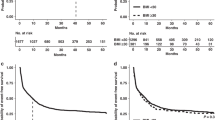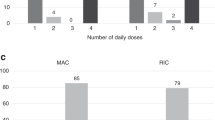Abstract
Weight-based dosing of intravenous busulfan is widely used in hematopoietic cell transplantation. However, a variety of dosing weights have been described. The objective of this retrospective study was to determine the pharmacokinetic impact of using ideal body weight as the initial dosing weight in obese as compared to non-obese transplant recipients. The secondary objectives were to describe the use of alternative dosing weights, the impact on survival, and the rates of toxicities. The mean steady-state concentration was 779.3 ng/mL (n = 82) in the non-obese cohort and 673.7 ng/mL (n = 63) in the obese cohort (p < 0.001). A smaller proportion of concentrations were below goal in the non-obese cohort (10% vs. 41%, p < 0.001). Ideal body weight and adjusted body weights with a 25 and 40% correction factor are appropriate in non-obese patients; adjusted body weights with a 25 and 40% correction factor are appropriate in obese patients. There was no difference in overall survival (p = 0.18); there was a difference in median progression-free survival (1078 vs. 500 days, p = 0.045) in the non-obese compared to obese cohorts. The use of ideal body weight to dose busulfan resulted in lower steady-state concentrations, a larger proportion of subtherapeutic concentrations, and worse progression-free survival in obese patients.
This is a preview of subscription content, access via your institution
Access options
Subscribe to this journal
Receive 12 print issues and online access
$259.00 per year
only $21.58 per issue
Buy this article
- Purchase on Springer Link
- Instant access to full article PDF
Prices may be subject to local taxes which are calculated during checkout


Similar content being viewed by others
References
Slattery JT, Clift RA, Buckner CD, Radich J, Storer B, Bensinger WI, et al. Marrow transplantation for chronic myeloid leukemia: the influence of plasma busulfan levels on the outcome of transplantation. Blood. 1997;89:3055–60.
Dix SP, Wingard JR, Mullins RE, Jerkunica I, Davidson TG, Gilmore CE, et al. Association of busulfan area under the curve with veno-occlusive disease following BMT. Bone Marrow Transplant. 1996;17:225–30.
Ciurea SO, Andersson BS. Busulfan in hematopoietic stem cell transplantation. Biol Blood Marrow Transplant. 2009;15:523–36. https://doi.org/10.1016/j.bbmt.2008.12.489
Andersson BS, Madden T, Tran HT, Hu WW, Blume KG, Chow DS, et al. Acute safety and pharmacokinetics of intravenous busulfan when used with oral busulfan and cyclophosphamide as pretransplantation conditioning therapy: a phase I study. Biol Blood Marrow Transplant. 2000;6(5A):548–54.
Busulfex [package insert]. Rockville, MD: Otsuka America Pharmaceutical Inc; 2015.
Clemmons AB, Evans S, DeRemer DL, Awan FT. Busulfan dosing (Q6 or Q24) with adjusted or actual body weight, does it matter? J Oncol Pharm Pract. 2015;21:425–32. https://doi.org/10.1177/1078155214541571
Andersson BS, Kashyap A, Gain V, Wingard JR, Fernandez H, Cagnoni PJ, et al. Conditioning therapy with intravenous busulfan and cyclophosphamide (IV BuCy2) for hematologic malignancies prior to allogeneic stem cell transplantation: a phase II study. Biol Blood Marrow Transplant. 2002;8:145–54.
Hadjibabaie M, Tabeefar H, Alimoghaddam K, Iravani M, Eslami K, Honarmand H, et al. The relationship between body mass index and outcomes in leukemic patients undergoing allogeneic hematopoietic stem cell transplantation. Clin Transplant. 2012;26:149–55. https://doi.org/10.1111/j.1399-0012.2011.01445.x
Lee JH, Choi SJ, Lee JH, Kim SE, Park CJ, Chi HS, et al. Decreased incidence of hepatic veno-occlusive disease and fewer hemostatic derangements associated with intravenous busulfan vs oral busulfan in adults conditioned with busulfan + cyclophosphamide for allogeneic bone marrow transplantation. Ann Hematol. 2005;84:321–30. https://doi.org/10.1007/s00277-004-0982-4
Aggarwal C, Gupta S, Vaughan WP, Saylors GB, Salzman DE, Katz RO, et al. Improved outcomes in intermediate- and high-risk aggressive non-Hodgkin lymphoma after autologous hematopoietic stem cell transplantation substituting intravenous for oral busulfan in a busulfan, cyclophosphamide, and etoposide preparative regimen. Biol Blood Marrow Transplant. 2006;12:770–7. https://doi.org/10.1016/j.bbmt.2006.03.016
Bubalo J, Carpenter PA, Majhail N, Perales MA, Marks DI, Shaughnessy P, et al. Conditioning chemotherapy dose adjustment in obese patients: a review and position statement by the American Society for Blood and Marrow Transplantation practice guideline committee. Biol Blood Marrow Transplant. 2014;20:600–16. https://doi.org/10.1016/j.bbmt.2014.01.019
Nguyen L, Leger F, Lennon S, Puozzo C. Intravenous busulfan in adults prior to haematopoietic stem cell transplantation: a population pharmacokinetic study. Cancer Chemother Pharmacol. 2006;57:191–8. https://doi.org/10.1007/s00280-005-0029-0
McDonald GB, Sharma P, Matthews DE, Shulman HM, Thomas ED. Venocclusive disease of the liver after bone marrow transplantation: diagnosis, incidence, and predisposing factors. Hepatology. 1984;4:116.
McDonald GB, Hinds MS, Fisher LD, Schoch HG, Wolford JL, Banaji M, et al. Veno-occlusive disease of the liver and multiorgan failure after bone marrow transplantation: a cohort study of 355 patients. Ann Intern Med. 1993;118:255.
Tkacz Brown V, Zahurak M, Hatfield Seung A, Rosner G, Jones RF, Luznik L, et al. Dosing of busulfan in overweight and obese patients compared to normal weight patients undergoing allogeneic hematopoietic stem cell transplantation. Biol Blood Marrow Transplant. 2012;18:S378 https://doi.org/10.1016/j.bbmt.2011.12.470. (abstract 474).
Kim JG, Sohn SK, Chae YS, Yang DH, Lee JJ, Kim HJ, et al. Multicenter study of intravenous busulfan, cyclophosphamide, and etoposide (i.v. Bu/Cy/E) as conditioning regimen for autologous stem cell transplantation in patients with non-Hodgkin’s lymphoma. Bone Marrow Transplant. 2007;40:919–24. https://doi.org/10.1038/sj.bmt.1705841.
Dean RM, Pohlman B, Sweetenham JW, Sobecks RM, Kalaycio ME, Smith SD, et al. Superior survival after replacing oral with intravenous busulfan in autologous stem cell transplantation for non-Hodgkin lymphoma with busulfan, cyclophosphamide and etoposide. Br J Haematol. 2010;148:226–34. https://doi.org/10.1111/j.1365-2141.2009.07940.x
Martinez C, Canals C, Sarina B, Alessandrino EP, Karakasis D, Pulsoni A, et al. Identification of prognostic factors predicting outcome in Hodgkin’s lymphoma patients relapsing after autologous stem cell transplantation. Ann Oncol. 2013;24:2430–4. https://doi.org/10.1093/annonc/mdt206.
Weiss BM, Vogl DT, Berger NA, Stadtmauer EA, Lazarus HM. Trimming the fat: obesity and hematopoietic cell transplantation. Bone Marrow Transplant. 2013;48:1152–60. https://doi.org/10.1038/bmt.2012.201
Sorror ML, Maris MB, Storb R, Baron F, Sandmaier BM, Maloney DG, et al. Hematopoietic cell transplantation (HCT)-specific comorbidity index: a new tool for risk assessment before allogeneic HCT. Blood. 2005;106:2912–9. https://doi.org/10.1182/blood-2005-05-2004
Sorror ML, Logan BR, Zhu X, Rizzo JD, Cooke KR, McCarthy PL, et al. Prospective validation of the predictive power of the hematopoietic cell transplantation comorbidity index: a center for international blood and marrow transplant research study. Biol Blood Marrow Transplant. 2015;21:1479–87. https://doi.org/10.1016/j.bbmt.2015.04.004
Navarro WH, Agovi MA, Logan BR, Ballen K, Bolwell BJ, Frangoul H, et al. Obesity does not preclude safe and effective myeloablative hematopoietic cell transplantation (HCT) for acute myelogenous leukemia (AML) in adults. Biol Blood Marrow Transplant. 2010;16:1442–50. https://doi.org/10.1016/j.bbmt.2010.04.009
Navarro WH, Loberiza FR, Bajorunaite R, van Besien K, Vose JM, Lazarus HM, et al. Effect of body mass index on mortality of patients with lymphoma undergoing autologous hematopoietic cell transplantation. Biol Blood Marrow Transplant. 2006;12:541–51. https://doi.org/10.1016/j.bbmt.2005.12.033.
Deeg HJ, Shulman HM, Anderson JE, Bryant EM, Gooley TA, Slattery JT, et al. Allogeneic and syngeneic marrow transplantation for myelodysplastic syndrome in patients 55 to 66 years of age. Blood. 2000;95:1188–94.
Servais S, Porcher R, Xhaard A, Robin M, Masson E, Larghero J, et al. Pre-transplant prognostic factors of long-term survival after allogeneic peripheral blood stem cell transplantation with matched related/unrelated donors. Haematologica. 2014;99:519–26. https://doi.org/10.3324/haematol.2013.089979
Walter RB, Buckley SA, Pagel JM, Wood BL, Storer BE, Sandmaier BM, et al. Significance of minimal residual disease before myeloablative allogeneic hematopoietic cell transplantation for AML in first and second complete remission. Blood. 2013;122:1813–21. https://doi.org/10.1182/blood-2013-06-506725
Ghobadi A, Nolley E, Liu J, McBride A, Stockerl-Goldstein K, Cashen A. Retrospective comparison of allogeneic vs autologous transplantation for diffuse large B-cell lymphoma with early relapse or primary induction failure. Bone Marrow Transplant. 2015;50:134–6. https://doi.org/10.1038/bmt.2014.198
Copelan EA, Bechtel TP, Avalos BR, Elder PJ, Ezzone SA, Scholl MD, et al. Busulfan levels are influenced by prior treatment and are associated with hepatic veno-occlusive disease and early mortality but not with delayed complications following marrow transplantation. Bone Marrow Transplant. 2001;27:1121–4.
Author information
Authors and Affiliations
Corresponding author
Ethics declarations
Conflict of interest
The authors declare that they have no conflict of interest.
Rights and permissions
About this article
Cite this article
Griffin, S.P., Wheeler, S.E., Wiggins, L.E. et al. Pharmacokinetic and clinical outcomes when ideal body weight is used to dose busulfan in obese hematopoietic stem cell transplant recipients. Bone Marrow Transplant 54, 218–225 (2019). https://doi.org/10.1038/s41409-018-0240-3
Received:
Revised:
Accepted:
Published:
Issue Date:
DOI: https://doi.org/10.1038/s41409-018-0240-3
This article is cited by
-
Busulfan
Reactions Weekly (2019)



